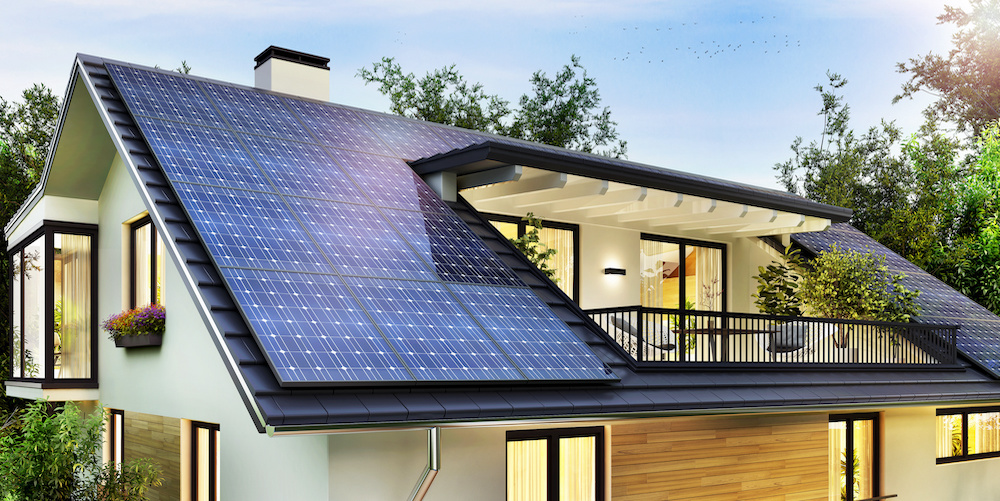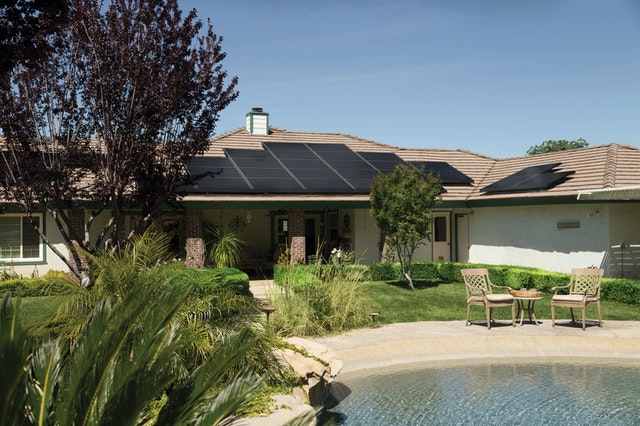

As consumers become more aware of the negative environmental impacts of fossil fuels and increasingly desire energy independence, the solar industry continues to grow. Year after year, the U.S. solar industry increases as advancements in technology continually lower the price of solar panels, resulting in a steady increase in new solar power installations for both residential and commercial customers.
Solar panels take in energy from the sun and output electrical power that can be used by homeowners to reduce monthly utility costs or, in some situations, completely eliminate the need to be connected to the electrical power grid. But how do solar panels accomplish this feat? How do they turn sunlight into electricity? Can solar-powered homes still use electricity at night? We’ll answer all your questions and more here.
The process by which solar panels produce electricity is actually relatively simple. In fact, for some context, the first solar panels were built way back in the 1800s! Solar panels utilize a phenomenon known by scientists and engineers as the “photovoltaic effect”, which describes a phenomenon where certain materials produce an electric current when exposed to light. Sunlight actually contains small amounts of electromagnetic radiation – but don’t worry, this isn’t the kind of radiation that will make you sick. When certain materials, such as the silicon used in modern solar panels, is exposed to this radiation, the material will emit electrons. Since electrons are particles that contain an electrical charge, a constant emission of these electrons results in the generation of electricity from plain old sunlight!
Because solar panels utilize the photovoltaic effect to generate electricity, they are officially referred to as photovoltaic (PV) panels.
Solar panels generate direct current (DC) because the electrons that they emit move in only one direction. You may recognize DC from batteries like your car battery; DC is the only form of electricity that can be stored in batteries. This differs from alternating current (AC), where electrons move back and forth in different directions. AC is by far the most common form of electricity for powering homes and appliances, and all modern electrical systems are based on AC since it is more efficient.
So, since solar panels produce DC, but homes require AC, how do solar panels provide power to your home? The answer is simple – residential solar installations always use an inverter. An inverter is a device that takes in the DC output from solar panels and converts it into AC that your home can use!
There are several methods for powering a home using solar panels, but the three most common are “grid-tied”, “grid-tied with battery backup”, and “off-grid”.
Grid-
tied solar installations reduce your monthly electric bill by sending energy from your home back into the electrical grid. Electric bills are based on meter readings which calculate how much electricity your home takes from the electrical grid. This electricity is measured in kilowatt-hours, and utility companies charge a set fee per kilowatt-hour used. When solar panels send electricity back into the electrical grid during the day, your electric meter essentially moves backward, reducing the amount of kilowatt-hours counted and subsequently reducing your electric bill.
For example, if your home uses 100 kWh in a month, but your solar panels produce 75 kWh, you will only be charged for the remaining 25 kWh.
Grid-tied with battery backup systems work almost exactly the same as grid-tied systems, with one key difference – these systems include a battery to provide backup power in case the electrical grid goes down. These systems are a bit more costly due to the additional cost of the backup battery, but they provide constant power in the event of an outage.
Since grid-tied systems send energy back into the electrical grid, not directly into your home, they will not provide power to your home if the electrical grid goes down
(in a power outage, for example). Systems with a battery backup store a portion of the energy produced by the solar panel in a large battery bank; then, if the system senses that the electrical grid is down, it automatically activates an inverter that provides power directly to your home. The amount of time that this backup power will last depends on two major factors: The capacity of the battery bank, and how much energy your home requires.
The final type of solar installation is off-grid. This system completely eliminates your home’s connection to the electrical grid, and instead solely relies on a battery bank for your electrical needs. Off-grid systems are typically the most expensive option, since they require the largest battery bank, but are useful for customers who want to completely eliminate their monthly utility bills. Keep in mind that virtually all utility bills include fees and taxes that are independent from energy usage; in other words, if you have a grid-tied system that provides 100% of your electricity needs, you will still have a small monthly electric bill due to fees. Off-grid systems eliminate this expense entirely.
The previously-described photovoltaic effect requires light to produce electricity, so the solar panels will not produce any energy during nighttime hours. Additionally, solar systems typically produce less energy on cloudy, rainy or snowy days due to reduced sunlight.
However, if your system is off-grid or has a battery backup, the battery will continue to supply energy to your home during the night as long as the batteries remain charged.
How do I set up solar panels?

Solar panels come in many different shapes and sizes, but there are a few basic rules to follow if you want to get the most out of your installation.
One popular option for solar installations is roof-mounted solar. As the name implies, this installation method uses your home’s existing roof as a mounting surface for solar panels. This method is popular in space-restricted locations that may not have enough land to dedicate to the panels. Tesla is even producing a “solar roof” product that styles the solar cells to look just like traditional roof tiles!
The other option is ground-mounted panels. Since solar panels are typically most efficient when facing southward, since they get maximum sun exposure this way, ground-mounted panels are often preferred when a home’s roof is not southern-facing, or if a customer dislikes the aesthetic of roof-mounted panels.
In addition to southern-facing, regardless of installation method, panels must be placed in direct sunlight with as little shade as possible.
A final important note is on degradation. It is normal for solar panels to degrade at a rate of approximately one-half percent per year; for example, ten years after initial installation, a solar system might only produce about 95% of its original output. Reputable solar installers often account for this degradation by installing a slightly larger system than required. In addition to panel degradation, batteries also degrade, and at a much faster rate. This degradation depends on many factors including battery bank construction, size, and maintenance requirements; however, most off-grid and battery backup owners can estimate needing a full battery replacement every five to seven years.
Whether you choose grid-tied, grid-tied with battery backup, or off-grid for your solar installation, you will likely discover that residential solar power can save a substantial amount on your electric bills. Solar panels become less expensive every year due to technological advances, and many governments also offer tax incentives for residential solar installation. Partner with a reputable solar installer to learn more about the benefits that solar power can have for your home.